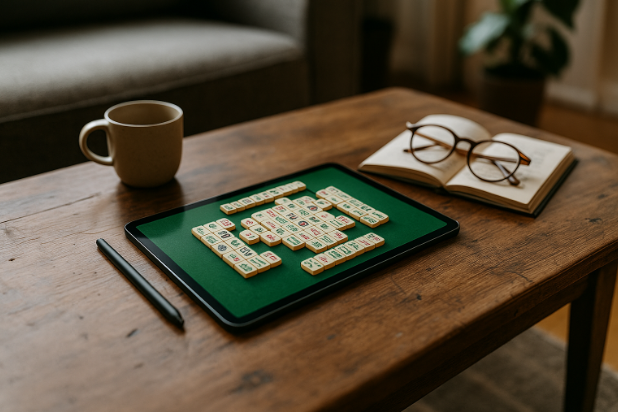Traditional games like Mahjong, Go, and Solitaire have a long history of being played on physical boards, with pieces and cards that can be physically manipulated. The rise of modern tablets has brought these games into a new environment without losing the familiarity of their original form. Players can now experience them with visual clarity and interaction methods that were once impossible outside a physical setting.
The technology behind tablet displays plays a key role in changing how players view and interact with traditional games. Enhancements in screen size, resolution, and input precision influence the clarity of the game state and the accuracy of player moves. These improvements make it easier to see every detail and act with greater precision.
Expansive Screen Size for Better Game Layouts
A larger display on a tablet allows complex traditional games to be viewed in their entirety without frequent zooming or scrolling. This saves time and nerves. On competitive platforms that run authentic four-player Mahjong, for example, where every decision counts, seeing the full board without constant adjustment makes it much easier to read opponents’ discards, plan faster hands, and avoid costly mistakes, which can decide the outcome of a game (source: mahjong365.com).
Other traditional games beyond Mahjong, such as chess and Go, also benefit from the added screen real estate. Chess players can observe the full set of pieces and the entire board at once, which allows for the creation of a clear mental map of possible moves. Go enthusiasts gain better awareness of stone positions and territory boundaries, which is critical for strategic planning. For almost all ancient board games, this ability to view every element simultaneously reduces interruptions in concentration and supports faster decision-making.
The larger screen also creates space for various interface components such as timers, score displays, or move history without cluttering the main playing area. Maintaining clean, accessible visuals helps players track ongoing changes and avoid mistakes caused by overlapping or hidden elements. Overall, expanded display size directly improves gameplay flow by combining full visibility with clear contextual information.
High‑Resolution Displays for Clearer Details
The ability to distinguish fine details matters – both in life and in traditional games. Tablets ensure this through high‑resolution screens that make sure every symbol, number, and line is sharp and clear. This reduces the chance of misreading a tile or card. In games like Mahjong, where tile markings can be intricate, or in card games with ornate designs, pixel density directly affects accuracy.
Apart from allowing for faster and easier play, high-resolution technology has its health benefits. Namely, according to a comprehensive review examining digital eye strain, advances in display design, such as higher pixel density, antireflective coatings, matte finishes, and smooth image rendering, reduce visual fatigue. This means that, thanks to high-technology screens, players can enjoy longer game sessions without losing clarity in the finer details or harming their health. The improvements manage an impossible task – preserve comfort, relieve eye stress, and maintain a steady level of focus over extended play.
Better resolution and display coatings also support a wider range of lighting conditions, which allows the same level of detail to be seen in daylight near a window or under indoor lighting at night. This consistency helps players keep their performance high, no matter where they choose to play.
Pen Input for Precision Moves
In some traditional games, precision is essential. This is most evident in examples where touching a small tile or card on a crowded board with a fingertip blocks the view or causes an unintended selection. A stylus or pen input solves this as it enables players to interact with the digital board with high precision, without covering the game elements.
This precision is especially useful in puzzle‑based games or crosswords, where handwriting recognition lets players enter answers naturally. The pen can also speed up gameplay in situations where dragging or drawing is faster than tapping through menus. For example, marking potential moves in Go or highlighting patterns in a tile‑matching puzzle becomes easier and more accurate when a pen is used.
Technologically speaking, unlike commands transferred by a finger, pen input unlocks a range of advanced possibilities, including pressure-sensitive gestures that allow players to confirm moves or erase marks with precision and control. These capabilities keep controls intuitive and natural while significantly reducing errors caused by accidental mistakes, unclear touches, or unintended inputs. In competitive play, where every move can influence the result, avoiding such mistakes is essential to maintaining an advantage.
Adaptive Brightness and True Tone Adjustments
Lighting conditions can change quickly during the play, and a display that adapts automatically is what keeps the view of the game consistent. This is done through adaptive brightness sensors that detect the surrounding light and adjust the screen’s output so that every element remains visible. Indoors, this prevents glare from lamps; outdoors, it increases brightness to counter direct sunlight.
Color temperature adjustments, such as True Tone, also secure the overall smoothness of the play as they make viewing comfortable by matching the screen’s white balance to the environment. That way, colors stay natural and strain during long play is reduced. In terms of traditional games played on boards, this technology means the background of a board or the color of tiles remains accurate without looking too harsh or too dull.
All these features work together to ensure one goal is achieved – a balanced visual experience. Thanks to their tight and synchronized collaboration, players can focus on strategy without pausing to manually adjust display settings. The game remains playable whether in a dim living room or on a bright patio.
Multi‑Touch Responsiveness for Group Play
It occasionally happens that due to game rules or a sudden hype, people need to share a screen to play. When this occurs, i.e., when 2 or more pens or fingers are touching the screen simultaneously, it becomes even more important that every move on the screen is registered with absolute accuracy. Inaccurate detection in such cases can cause delays or missed moves, which can interrupt the flow of the game completely. This is where and why responsive multi‑touch technology enters the scene, ensuring with 100% certainty that each input is recognized instantly, even if players act at the same time.
Numbers clearly show how useful and loved this technology is. For example, the interactive touch table industry, which is built on multi-touch responsiveness, is expected to grow from $1,314.5 million in 2025 to $2,390.7 million by 2032. This growth reflects both strong confidence in and rising demand for screens that register multiple inputs with precision and no time lag, which is precisely the quality that makes group play on tablets smooth and enjoyable.
Moreover, in turn‑based games like digital board versions of Ludo or cooperative card games, this responsiveness prevents disputes about whether a move was made in time. It also supports faster play when multiple participants can interact without waiting for each other’s inputs to register.
Split‑Screen or Picture‑in‑Picture for Game Guides
Some traditional games have complex rules or scoring systems, and keeping reference materials close can help resolve potential disputes quickly, to be able to can continue playing without interrupting the rhythm. In such cases, split‑screen mode becomes of great assistance. It allows players to keep the main game open on one side while displaying a digital rulebook, score chart, or tutorial on the other. This avoids switching back and forth between apps, which can interrupt concentration.
Picture‑in‑Picture takes this further by floating a small window, such as a timer or a video of an opponent’s moves, over the game. This way, essential information is visible and important parts of the board remain uncovered. For example, a Mahjong player could watch a short strategy guide in the corner while still tracking live gameplay.
These tools turn the tablet into a multi‑purpose gaming station. They reduce downtime and give game fans the resources they need without making them leave the game environment.
Conclusion
Tablet displays will continue to evolve, and the improvements ahead can make traditional games even more encompassing. Higher refresh rates could help tiles slide into place more smoothly, while foldable or expanding screens could potentially allow for full‑size boards that still fit in a bag. Such changes would bring an even closer match to the feel of physical play.
The most important features to check when choosing a tablet for games initially developed to be played with tiny stones and wooden boards are pixel density, touch accuracy, and adaptive lighting. A screen that shows every detail clearly and responds instantly to every move will make the game run at a natural pace, and this, above all other important factors, will preserve the enjoyment and the competitive thrill everybody joined in for in the first place.










Recent Comments